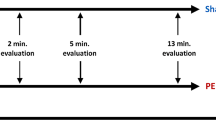Summary
Pulmonary thromboembolism is one of the most frequent causes of death in our days. Notwithstanding the great efforts made in clinical and experimental medicine there has been no success as yet in filling the existing gaps in the understanding of pathophysiology of this disease.
The blood electrically activated in vitro by direct current reacts like an endogenic thrombogenic substance. On the condition that such a substance is injected into the inferior vena cava, the clot is introduced into the pulmonary circulation and gives rise to pulmonary thromboembolism of a varying degree, each depending on the electrically activated blood injected. In the animal experiment it has thus become feasible, under standardized and reproducible conditions, to produce severe thromboembolism or chronic microembolism with subsequent hypertrophy of the right ventricle.
The object of this contribution is a demonstration of a new, easy, and effective method for the induction of pulmonary embolism, which can be treated by thrombolysis.
Similar content being viewed by others
References
Alpert JS, Haynes FW, Dalen JE, Dexter L (1974) Experimental pulmonary embolism. Circulation 69:152–157
Baitsch G, Grädel E (1983) Lungenembolie. In: Koller F, Duckert F (Hrsg) Thrombose und Embolie, Bd. 2. Schattauer, Stuttgart New York, S 545–568
Barnard PJ (1953) Experimental fibrin thromboembolism of the lungs. J Pathol Bacteriol 65:129–139
Boerema B (1968) Appearance and regression of pathological changes in the pulmonary arterial wall after repeated air embolism. J Cardiovasc Surg 6:160–162
Cade J, Hirsh J, Regoeczi E (1975) Mechanism for elevated fibrin-fibrinogen degradation products in acute experimental pulmonary embolism. Blood 45:563–568
Daley R, Wade JD, Maraist F, Bing RJ (1951) Pulmonary hypertension in dogs induced by injection of lycopodium spores into the pulmonary artery, with special reference to the absence of vasomotor reflexes. Am J Physiol 164:380–390
Eichelter R, Schenk WG (1969) Hemodynamic changes following experimental pulmonary embolism. J Thorac Cardiovasc Surg 52:866–872
Gore I, Tanaka I, Nakashima I, Larkey BJ (1962) Pulmonary vascular lesions following the repeated intravascular administration to thromboplastin. Am J Pathol 41:77–93
Harrison CV (1951) Experimental pulmonary hypertension. J Pathol Bacteriol 63:195–200
Heard BE (1952) An experimental study of thickening of the pulmonary arteries of rabbits produced by the organisation of fibrin. J Pathol Bacteriol 64:13–19
Jaques WE, Hyman AL (1957) Experimental pulmonary embolism in dogs. Arch Pathol 64:487–493
Johnson WC, Widrich WC, Patten DH, Asinari J, Nabseth DC (1978) Effect of streptokinase on canine pulmonary emboli: Local vs peripheral infusion. J Surg Res 24:366–373
Könn G, Schejbal V (1974) Pathologie der Lungenarterienembolie. Med Klin 69:167–174
Könn G, Schejbal V (1981) Pathologisch-anatomische Befunde bei Lungenthrombembolien. Atemw Lungenkrankh 7:83–88
Kux M, Massion WH (1973) Reflex changes in pulmonary hemodynamics resulting from microembolism. Eur Surg Res 5:301–310
Mazuch J, Pavlik V, Kukura A, Redakovic M (1976) Acute massive pulmonary thromboembolism in experiment. Comparison of the effect of fibrinolytic and anticoagulant treatment. Acta Med Acad Sci Hung 35:317–329
Moser KM, Guisan M, Bartimmo EE, Longo AM, Harsanyi PG, Chiorazzi N (1973) In vivo and post-mortem dissolution rates of pulmonary emboli and venous thrombi in the dog. Circulation 48:170–178
Muirhead EE, Montgomery POB (1951) Thrombo-embolic pulmonary arteritis and vascular sclerosis: Its experimental production in rabbits by means of intravenously injected human amniotic fluid and autogenous blood clots. Arch Pathol 52:505–517
Sakakihara Y, Bierry DN, Polishook RD, Wagner DE, Baum S, Nusbaum M (1970) Selective lysis of pulmonary clots. Surg Gynecol Ostet 130:821–828
Sedlarik K (1983) Über den Einfluß der Wirkung des anodischen Gleichstroms in vitro auf die Eigenschaften des venösen Blutes. Folia Haematol (Leipz) 110:112–116
Singer D, Saltzman PW, Rivera-Estrada C, Pick R, Katz LN (1957) Hemodynamic alternations following miliary pulmonary embolisation in relation to the pathogenesis of the consequent diffuse edema. Am J Physiol 191:437–442
Thomas WA, O'Neal RM, Lee KT (1956) Experimental pulmonary hypertension and arteriosclerosis. Arch Pathol 62:56–61
Wallace CR, Hamilton WF (1962) Study of spontaneous congestive heart failure in the dog. Circ Res 6:301–314
Wartmann WA, Jennings RB, Hudson B (1951) Experimental arterial disease. The reaction of the pulmonary artery to minute emboli of blood clot. Circulation 4:747–755
Weisberg H, Kline I, Jartner R, Ellis A, Katz LN (1963) The effect of starch embolisation on cardiac output of the dog. Circulation 28:823–829
Wessler S (1975) Venous thromboembolism: scope of the problem. In: Fratantoni J, Wessler S (eds) Prophylactic therapy of deep vein thrombosis and pulmonary embolism. Washington DC; US Dept. of Health, Education, and Welfare, Publication no (NIH) 76-866, pp 1–10
Wessler S, Freiman DG, Ballon JD, Katz JH, Wolff R, Wolf E (1961) Experimental pulmonary embolism with serum-induced thrombi. Circulation 38:89–101
Author information
Authors and Affiliations
Rights and permissions
About this article
Cite this article
Sedlarik, K.M., Mönch, C., Haenselt, V. et al. Experimental pulmonary embolism with electrically activated autologous blood. Res. Exp. Med. 186, 271–284 (1986). https://doi.org/10.1007/BF01852304
Received:
Accepted:
Issue Date:
DOI: https://doi.org/10.1007/BF01852304




